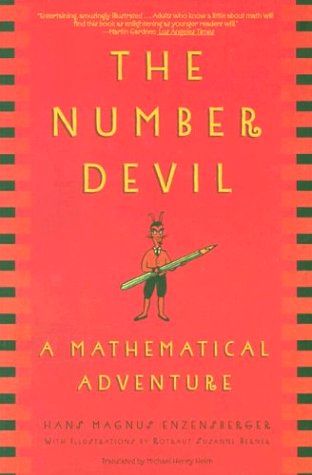The number devil: a mathematical adventure
Hans Magnus Enzensberger and Rotraut Susanne Berner and Rotraut Susanne Berner (ill.)
Enzensberger, Hans Magnus; Rotraut Susanne Berner; Rotraut Susanne Berner (ill.);
The number devil: a mathematical adventure
Metropolitan / Henry Holt, 1998, hardback 262 pages
ISBN 0805057706, 9780805057706
topics: | math | young-adult |
a dream-fantasy in which a "number devil" appears in the dreams of robert, and initiates him into the pleasures of mathematics.
robert often has dreams in which a huge fish is gobbling him up, or he is falling down an endless slide, so when the number devil starts coming in his dream, it is a welcome relief.
in robert's dreams, he is often swallowed by a big ugly fish in the first dream, the number devil introduces the infinitude of integrers, and introduces the multiplication series: 11 x 11 = 121 111 x 111 = 12321 1111 * 1111 = 1234321 but the series breaks down when there are more than ten one's, causing the number devil to explode and disappear.
devil explodes when he realizes that 11 111 111 111 squared does not follow the pattern (answer is 1234567 9012098 7654321) the second dream deals with zero and its importance in representing numbers, contrasting robert's birth year (1986) as written in roman (MCMLXXXVI). Squaring is called making numbers "hop"; and 1986 is explained in terms of hops of ten - the positional system. Still in a daze the next morning, Robert said to his mother, "Do you know the year I was born? It was 6x1 and 8x10 and 9x100 and 1x1000." "I don't know what's got into the boy lately," said Robert's mother... p. 46
devil breaks into a huge grin, revealing an endless series of teeth... The third night introduces the prime numbers, and how finding prime factors is a difficult task. Fourth dream deals with irrational numbers (called "unreasonable") and square roots (called "rutabagas"). the fifth chapter (dream) introduces the triangle numbers 1, 3, 6, 10, ... and its relations to the square numbers (4 = 1+3; 9 = 3+6 etc). The sum of the first n triangle numbers = n+1-th triangle number = (1 + n) + (2 + n-1) + ... giving the relation n-1. n /2. subsequent dreams deal with Fibonacci numbers, pascal's triangle and its many properties, combinations and permutations etc. the inverted triangle composites (evens, multiples of five) in the pascal triangle were quite interesting for me also:
inverted triangles emerge when looking at multiples of two. similarly, for multiples of five, etc. the relation between combinations and pascal's triangle is developed through an interesting relationship:
the diagonals are nC2, nC3 etc. even nC8. the tenth night introduces the golden section (sqrt(5)+1)/2; solution of the recursive fraction x = 1 + 1/x; however this discussion is left half-finished as the discourse moves to euler's relation f+v = e+1, and then to solids. the eleventh night is one of the more abstract, where the process of mathematical proof is explained as a series of jumps across stones on a mountain river - whether one can reach the other shore or not remains uncertain. the final chapter introduces some historical figures (gustav klein is translated as "dr. happy little". the number devil is given a mayan name, teplotaxl. on the whole, though there is no plot to speak of, but the illustrations and the intrinsic interest of the matter keeps you going. the book's style and getup and its big fonts and well-executed illustrations are quite appealing. certainly not for very young children, though. a historical quibble: the invention of zero is attributed to an ancient chinese scholar. (12th night, p.245).
amitabha mukerjee (mukerjee [at-symbol] gmail) 2011 Oct 31
